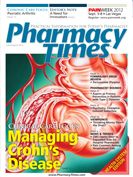Publication
Article
Pharmacy Practice in Focus: Health Systems
Pharmacist Rounds: Aspirin as Primary Prevention in Patients with Type 2 Diabetes
Case
A 43-year-old male (AB) with type 2 diabetes who was admitted to the hospital for communityacquired pneumonia. He has no other past medical history, denies smoking or alcohol use, and has no pertinent family medical history. While at the hospital he receives 3 days of levofloxacin for pneumonia; his lab results are all within normal levels and he has a normal lipid panel. Upon discharge he is given a prescription for an additional 2 days of antibiotics and asked to continue only his metformin 500 mg twice daily. Before the medical team discharges AB, they ask the clinical pharmacist if he should be on aspirin for primary prevention of cardiovascular (CV) events due to his diabetes.
Answer
In patients 50 years or older without evidence of CV disease, the 9th edition CHEST guidelines on antithrombotic therapy recommend low-dose aspirin daily given the modest benefit in total mortality for patients on aspirin over 10 years.1 This grade 2B recommendation is weak due to the closely balanced trade-off between myocardial infarction reduction and major bleed increase. The higher a patient’s CV risk, the more value the patient may place on coronary heart protection over gastrointestinal bleed while on chronic aspirin therapy. Prescribing practices have incorporated more emphasis on patient preference, which is evidenced by the new inclusion of patient value studies in the CHEST guidelines 9th edition, previously not found in the 8th edition.2 Patient value and preference strongly predict medication adherence and adherence, is essential to deriving benefit from any medication. Since AB is only 43 years old, the CHEST recommendation would not apply to him.
Diabetes, a CV risk factor for AB, should provide more insight for the initiation of aspirin therapy as primary prevention of MI and stroke. Diabetes is well known to be associated with higher risks for CV events, and secondary prevention with aspirin is highly supported.3
Whether the risk of CV events in patients with diabetes translates to greater benefit with aspirin as primary prevention is not as well established in studies. Previous large scale trials, the Early Treatment of Diabetic Retinopathy Study (ETDRS) and the British POPADAD trial, have failed to show a significant benefit with chronic aspirin in primary prevention in the high-risk diabetes population, although the results suggest a trend toward benefit, which has sparked the impetus for evaluation of the role of aspirin in 2 ongoing larger trials.4,5
Diabetes could affect nearly one-third of all Americans by 2050 at the current rate, per the CDC.6 The potential value of MI and stroke prevention with an inexpensive and easily accessible drug was addressed by a consensus from the American Diabetes Association, American Heart Association, and American College of Cardiology to recommend aspirin (75 to 162 mg/day) for primary prevention in any patient with diabetes at increased CV risk (10-year risk >10 percent), which would include most men >50 years and women >60 years who have at least 1 additional CV risk factor (eg, cigarette smoking, hypertension, obesity, albuminuria, dyslipidemia, or a family history of coronary heart disease).7 There is no evidence to recommend aspirin for primary prevention in patients 30 years or younger, nor is aspirin safe in children, due to the risk of Reye’s syndrome.7
The National Cholesterol Education Program Recommend-ations identified the following risk factors to evaluate a patient’s 10-year risk for CHD event, known as the Framingham score: cigarette smoking, hypertension, low highdensity lipoprotein cholesterol, family history of premature CHD (CHD in male first-degree relative less than 55 years of age; CHD in female first-degree relative less than 65 years of age), and age (men greater than 45 years; women greater than 55 years). 8
In applying these guidelines to AB, since he has no additional risk factors his Framingham score purports a 10 year risk of <10%, thus he would not be an ideal candidate for aspirin as primary prevention until he reaches the age of 50 years or his Framingham score exceeds 10%, at which time he would reap greater benefit from the preventive effects of aspirin compared with the risk of bleed.
Tran H. Tran, PharmD, BCPS, is an Assistant Clinical Professor, St. John’s University, Clinical Pharmacy Manager, New York-Presbyterian Hospital/Columbia. Ruchi Tiwari, PharmD, MS, is Pharmacy Manager at New York-Presbyterian Hospital
References
1. Vandvik, PO, Lincoff AM, Gore JL, et al. Primary and Secondary Prevention of Cardiovascular Disease: antithrombotic therapy and prevention of thrombosis, 9th ed: American College of Chest Physicians evidence-based clinical practice guidelines. CHEST. 2012 Feb; 141(2 suppl): e6375-e6685.
2. Guyatt GH, Bhatnagar N, McLeod S, et al. Patient values and preferences in decision making for antithrombotic therapy: a systematic review: Antithrombotic Therapy and Prevention of Thrombosis, 9th ed: American College of Chest Physicians Evidence-Based Clinical Practice Guidelines. http://www.ncbi.nlm.nih.gov/pubmed/22315262 CHEST. 2012 Feb;141(2 Suppl):e1S-23S.
3. Antithrombotic Trialists' Collaboration. Collaborative meta-analysis of randomised trials of antiplatelet therapy for prevention of death, myocardial infarction, and stroke in high risk patients. BMJ. 2002 Jan 12;324(7329):71-86
4. De Berardis G, Sacco M, Evangelista V, et al. The ACCEPT-D Study Group et al. Aspirin and simvastatin combination for cardiovascular events prevention trial in diabetes (ACCEPT-D): design of a randomized study of the efficacy of low-dose aspirin in the prevention of cardiovascular events in subject with diabetes mellitus treated with statins. Trials. 2007;8:21—29.
5. Nicolucci A. Aspirin for primary prevention of cardiovascular events in diabetes: still an open question. JAMA. 2008 Nov 12; 300(18):2180-1. Epub 2008 Nov 9.
6. Centers for Disease Control and Prevention. Getting the facts on diabetes. Retrieved June 21, 2012 from http://www.cdc.gov/Features/DiabetesFactSheet/.
7. American Diabetes Association. Standards of medical care in diabetes--2012. Diabetes Care. 2012;35 Suppl 1:S11.
8. Grundy SM, Cleeman JI, Merz CN, et al. Implications of recent clinical trials for the National Cholesterol Education Program Adult Treatment Panel III guidelines. Circulation 2004;110:227-39.

Newsletter
Stay informed on drug updates, treatment guidelines, and pharmacy practice trends—subscribe to Pharmacy Times for weekly clinical insights.






